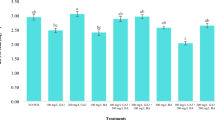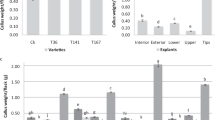Abstract
IN the course of an investigation of inter-varietal differences in the growth of excised roots of field peas (Pisum sativum L. var. arvense), some effects of gibberellic acid have been observed which seem worthy of brief record. Seeds were surface sterilized with 0.1 per cent mercuric chloride and germinated for two days. Root tips (5 mm.) were excised and grown in the dark at 25° C. in Petri dishes containing the inorganic medium of Bonner and Addicott1 with 4 per cent sucrose, vitamin B1 (0.1 mgm./l.) and nicotinic acid (0.5 mgm./l.). Ten tips were employed in each treatment, two being grown in each dish. After seven days the roots were measured and the apical 10 mm. of each was transferred to fresh medium for a further week.
This is a preview of subscription content, access via your institution
Access options
Subscribe to this journal
Receive 51 print issues and online access
$199.00 per year
only $3.90 per issue
Buy this article
- Purchase on Springer Link
- Instant access to full article PDF
Prices may be subject to local taxes which are calculated during checkout
Similar content being viewed by others
References
Bonner, J., and Addicott, F. T., Bot. Gaz., 99, 144 (1937).
Brian, P. W., Hemming, H. G., and Radley, M., Physiol. Plant., 8, 899 (1955).
Cormack, R. G. H., Bot. Rev., 15, 583 (1949).
Author information
Authors and Affiliations
Rights and permissions
About this article
Cite this article
PECKET, R. Effects of Gibberellic Acid on Excised Pea Roots. Nature 185, 114–115 (1960). https://doi.org/10.1038/185114a0
Issue Date:
DOI: https://doi.org/10.1038/185114a0
This article is cited by
-
Growth and Morphogenesis of Striga Seedlings
Nature (1961)
Comments
By submitting a comment you agree to abide by our Terms and Community Guidelines. If you find something abusive or that does not comply with our terms or guidelines please flag it as inappropriate.



